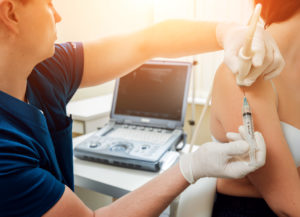How Does PRP Therapy Work?
More and more, healing professionals are turning to drug-free and less invasive treatments to help patients with painful conditions and loss of full function. One of these innovative treatments is platelet-rich plasma (PRP) therapy. PRP procedures are now being performed regularly by medical professionals, including chiropractic doctors and orthopedic physicians.
Who is an appropriate candidate for PRP therapy?
PRP therapy may be a useful intervention for patients who have injuries to tissues with reduced blood supply, like ligaments and tendons. These tissues often undergo microscopic tears or chronic scarring. The human body, despite its vast healing potential, has a difficult time healing tissues with inadequate blood supply. Plus, once an old injury heals over with scar tissue, the body may not recognize the injury site and may not take steps to initiate healing. Fortunately, PRP treatment can intervene to initiate a healing response that makes an ongoing, chronic condition appear as if it were a new injury. Thus, the injured or scarred tissue is triggered to engage a new or renewed healing response.
Which injuries can PRP therapy be used to treat?
PRP is being used routinely at the highest levels of sport and in many progressive medical offices. Conditions that may be treated successfully with PRP therapy include:
Shoulder
- Rotator cuff tendinitis
- Bicipital tendinitis
- Shoulder impingement
- Bursitis
Neck and back
- Rib problems
- Facet joint arthritis
Wrist and hand
- Tendinitis
- Ligament tears
- Quervain’s tenosynovitis
Elbow
- Tennis elbow
- Golfer’s elbow
Hip
- Sacroiliac joint dysfunction
- Iliotibial band tendonitis (ITB Syndrome)
- Greater trochanteric bursitis
- Ilio-psoas tendonitis and bursitis
Knee
- Partially torn or strained knee ligaments (ACL, LCL, MCL, or PCL)
- Patellar tendinitis
Ankle and foot
- Achilles tendinitis
- Recurrent ankle sprains
- Peroneal tendonitis
- Other foot or ankle tendinitis
PRP treatment may work best for incomplete, chronic degeneration and tears of ligaments and tendons. Indeed, many chronic conditions may respond favorably to PRP therapy.
How is PRP therapy performed?
PRP therapy is a relatively straightforward and pain-free treatment. The medical provider starts by drawing a blood sample from the patient. Then, the patient’s blood is processed in a centrifuge to separate and concentrate the platelet-rich portion of whole blood. This platelet-rich portion of the blood is rich in growth factors, which can trigger an injured area to repair and regenerate. The PRP sample is then injected back into the patient at the site of the injury, typically using an imaging technique to place it accurately. Then, the body’s own regenerative processes engage and work to repair the damaged tissue.
Who provides PRP therapy?
Many chiropractic doctors are adding PRP treatment to their practices. Chiropractors offer many treatment protocols for healing musculoskeletal injuries, so PRP techniques fit in well with other chiropractic healing treatments. With so many options for healing patients, a chiropractor can design a comprehensive treatment protocol for injuries or people with chronic pain and functional limitation.
Indeed, chiropractic care with PRP therapy might be just the thing you need to avoid an invasive surgical procedure with an extended recovery time.

